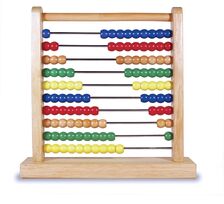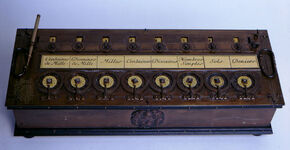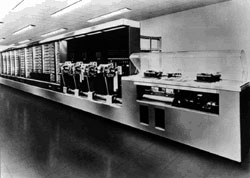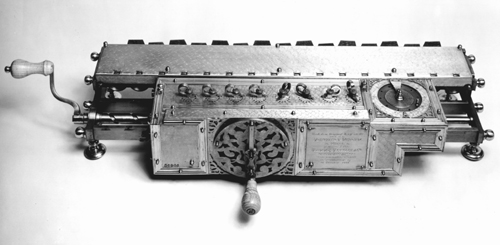The concept of a computer did not materialised overnight. Over the ages, the computer took thousands of years to mature.
Ancient people used stones for counting or made scratches on a wall or tied knots in a rope to record information. But all these were manual computing techniques. Attempts had been going on developing faster computing device used by man.
Abacus[]

Around 3000 years before birth of Christ, the mesopotamians quite unknowingly laid the foundation of computer era. They discovered the earliest form of a bead-and-wire counting machine, which subsequently came to be known as abacus. The Chinese improved upon the abacus so that they could count and calculate fast.
An abacus consists of beads divided into two parts which are movable on the rods of the two parts. Addition and multiplaction is done by using the place value of the digitd of the numbers and position of beads in the abacus.
Napier's 'Logs' and 'Bones'[]
John Napier developed the odea of Logarithm. He used 'logs' to tranform mulyiplication problem to addition problem. Napoer's logs later became a well-known invention- the computing machine known as 'slide rule'. Napier also devised a set of numbering rods known as Napier's Bones. He could perform both multiplication and division with these 'Bones'.
The idea of logarithm notably reduced the tedium of repetitive calculations.
Pascal's Adding Machine[]

Pascal's Adding machine.
Blaise Pascal, a french mathematician, invented a machine in 1652 made up pf gears which was used for adding numbers quickly. This machine was named as Addinh Machine(also called Pascaline) and was capable of addition and subtraction. It worked on clockwork mechanism principle. The adding machine consisted of numbered toothed wheels having unique position values. The rotation of wheels controlled the addition anf subtraction operations. This machine was capable of carry-transfer automatically.
Leibnitz Calculator[]

Leibnitz's Calculator
Gottfried Leibnitz improved an adding machine and constructed a new machine in 1671 that was able to perform multiplication and division as well. This machine performed multiplication through repeated addition of numbers. Leibnitz's machine used stepped cylinder each with nine teeth of varying lengths instead of wheels as was used by Pascaline.
Jacquard's Loom[]
Joseph Jacquard manufactured punched cards at the end of American revolution and used them to control looms in 1901. Thus the entire control weaving process was automatic. The entire operation under a program's control. With the historic invention of punched cards, the era of storing and retrieving information started that greatly influenced the later inventions and advancements.
Babbage's Difference Engine[]

Difference Engine
Charles Babbage developed a machine called Difference Engine in the year 1822. This machine was expected calculate logarithmic tables to a high degree of precision. The difference engine was made to calculate various mathematical functions. The machine was capable of polynomial evaluation by finite difference and its operation was automatic multistop operation.
Babbage's Analytical Engine[]

Analytical Engine which could not be built during Babbage's time due to lack of technology.
In 1833, Charles Babbage started designing an Analytical Engine which was to become a real ancestor of the modern day computer. With the methodical design of his Analytical Engine, Babbage meticulously established the basic principle on which today's computers work. The analytical Engine was capable of performing all four arithmetic operations as well as comparison. It had a number of features startingly similar to those in today's electronic computers. He included the concept of central processor, storage area, memory and input-output devices in his design. The two revolutionary innovations incorporated in Analytical engine were comparisons and modification of stored information. the first innovation enabled the machine to compare quantities and then decide which of the instruction sequences to follow. The second permitted the results of a calculation to change numbers and instructions already stored in the machine. Owing to the lack of technology of the time, the Analytical engine was never built. Its design remained conceptual.
Hollerith's Machine[]

Tabulating Machine
In 1887, an American named Herman Hollerith fabricated what was dreamt of by Charles Babbage. He fabricated the first electromechanical punched-card tabulator called as Tabulating machine that used punched cards for input, output and instructions. This machine was used by American Department of Census to compile their 1880 censs data and were able to complete compilation in 3 years which earlier used to take around 10 years.
Operation[]
In its basic form, a tabulating machine would read one card at a time, print portions (fields) of the card on fan-fold paper, possibly rearranged, and add one or more numbers punched on the card to one or more counters, called accumulators. On early models, the accumulator register dials would be read manually after a card run to get totals. Later models could print totals directly. Cards with a particular punch could be treated as master cards causing different behaviour. For example, customer master cards could be merged with sorted cards recording individual items purchased. When read by the tabulating machine to create invoices, the billing address and customer number would be printed from the master card, then individual items purchased and their price would be printed. When the next master card was detected, the total price would be printed from the accumulator and the page ejected to the top of the next page, typically using a carriage control tape.
With successive stages or cycles of punched-card processing, fairly complex calculations could be made if one had a sufficient set of equipment. (In modern data processing terms, one can think of each stage as an SQL clause: SELECT (filter columns), then WHERE (filter cards, or "rows"), then maybe a GROUP BY for totals and counts, then a SORT BY; and then perhaps feed those back to another set of SELECT and WHERE cycles again if needed.) A human operator had to retrieve, load, and store the various card decks at each stage.[NOTE]
Mark-I[]

Mark-I Computer
Professor Howard Aiken in USA constructed in 1943 an electro-mechanical computer named Mark-I which multiply two 10-digit number in 5 seconds- a record at that time. Mark-I was the first machine which could perform according to pre programmed instructions automatically without any manual interference. This was the first operational general purpose computer.
Modern Computers[]
First Generation Computers[]
Existence: 1949- 1955
Key Features[]
History[]
The first generation computers used thermionic valves(vacuum tubes) and machine language was used for giving instructions. The first generation computers used the concept of 'stoned program'. The computers of this generation were very large in size and their programming was a difficult task. Below is a list of some of the first generation computers:
- ENIAC
- EDSAC
- EDVAC
- UNIVAC-I
Initial applications of the computers at that time were in science and engineering but due to the emergence of UNIVAC-1 the prospects of commercial application were perceived.
Computing History Timeline[]
This slideshow is incomplete. Complete this slideshow by getting help from http://www.cassiopeia.it/resources/museum/.








